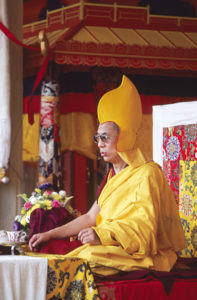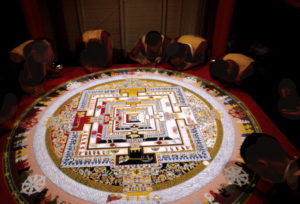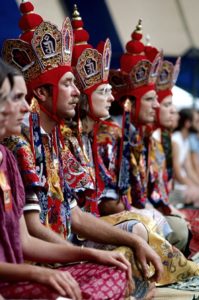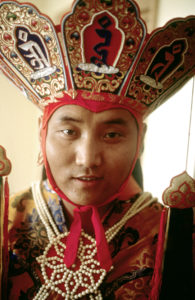The Dalai Lama's Gift ~ Wheel of Time
The Dalai Lama's Gift to the World
Wheel of Time
Kālachakra
Deer Park Monastery, 1981
 The Kalachakra, or Wheel of Time, initiation is generally regarded as the most famous of all Tibetan Buddhist Tantric empowerments. It contains awe-inspiring art, an intricately colorful sand mandala, deity costuming, and entrancing music that inspire the imaginal practices required to achieve enlightened wisdom and compassion to end suffering and to create peace in the world.
The Kalachakra, or Wheel of Time, initiation is generally regarded as the most famous of all Tibetan Buddhist Tantric empowerments. It contains awe-inspiring art, an intricately colorful sand mandala, deity costuming, and entrancing music that inspire the imaginal practices required to achieve enlightened wisdom and compassion to end suffering and to create peace in the world.
It is believed to have been taught 2500 years ago by the Buddha to the king of Shambhala and was finally returned to India and Tibet in the 11th Century CE. Now, a thousand years later, its hidden meaning will be revealed to a global television audience.
In July of 1981, history was made as the Dalai Lama presented the Wheel of Time (Kalachakra) Initiation in the US at Deer Park Monastery near Madison, Wisconsin. It was the first time it had been presented outside Tibet or India. This majestic ceremony imbued Western participants with the transcendent practices that could lead them to perfect enlightenment. This event was to become one of thirty-four Kalachakra initiations bestowed on over a million people throughout the world.
This film will tell the story of a journey of discovery of the meaning and purpose of the Wheel of Time, why it was first bestowed by the Dalai Lama at Deer Park Monastery, its impact on the initiates, the challenges overcome by the organizers and its seminal role in the transmission of Tibetan Buddhism to America and the world.
 In 1981, film director Dr. Ed Bastian, working closely with coproducer Sharpa Tulku, Geshe Sopa and the Monks of Namgyal Monastery, assembled a film team to document this event, including the extensive preparations in India and the US, the construction of the first Kalachakra Temple in America, and the initiation itself. The footage includes interviews with His Holiness the Dalai Lama, Geshe Lhundup Sopa (the US host and organizer), as well as American initiates, many of whom would later become significant Buddhist teachers. Additional footage shot in 2016 and 2022-3 includes interviews with world-renowned experts and participants who attended the event in 1981, and a first-ever animation of the majestic three-dimensional mandala to be imagined by initiates in the seven-step initiation. Our film will document the historic merger of ancient mystical Buddhist practices into Western culture and its impact on millions of people.
In 1981, film director Dr. Ed Bastian, working closely with coproducer Sharpa Tulku, Geshe Sopa and the Monks of Namgyal Monastery, assembled a film team to document this event, including the extensive preparations in India and the US, the construction of the first Kalachakra Temple in America, and the initiation itself. The footage includes interviews with His Holiness the Dalai Lama, Geshe Lhundup Sopa (the US host and organizer), as well as American initiates, many of whom would later become significant Buddhist teachers. Additional footage shot in 2016 and 2022-3 includes interviews with world-renowned experts and participants who attended the event in 1981, and a first-ever animation of the majestic three-dimensional mandala to be imagined by initiates in the seven-step initiation. Our film will document the historic merger of ancient mystical Buddhist practices into Western culture and its impact on millions of people.
 The original footage was shot in 1981. But, unable to immediately complete the film, Ed Bastian deposited the twenty-five hours of 16 mm color film in the Smithsonian Institution Film Archives for its preservation. Happily, the content and the quality are extremely well preserved, and we have now assembled an excellent production and editing team to complete the project. The film has been digitized, and we are now conducting interviews with original participants and world-renowned experts who will bring this story to life.
The original footage was shot in 1981. But, unable to immediately complete the film, Ed Bastian deposited the twenty-five hours of 16 mm color film in the Smithsonian Institution Film Archives for its preservation. Happily, the content and the quality are extremely well preserved, and we have now assembled an excellent production and editing team to complete the project. The film has been digitized, and we are now conducting interviews with original participants and world-renowned experts who will bring this story to life.
Four Interwoven Content Elements
1. Historical and Cultural Context
- The Wheel of Time and Buddhism in Tibet.
- The connection between Kalachakra and Shambhala.
- The Chinese takeover and destruction of Buddhist monasteries and religious freedom.
- Tibetan refugees in India and the Dalai Lama’s efforts to preserve their religious culture.
- The diaspora Tibetans throughout Europe and America.
- Historic interviews with the Dalai Lama in India (1981).
2. Tibetan Buddhism Comes to America
- Young Americans studying with Tibetan teachers in India and bringing them back home.
- Building the Kalachakra Temple at Deer Park Monastery near Madison, WI.
- County Board attempts to stop the event, and their eventual meeting with the Dalai Lama.
- Numerous funding, political and logistical obstacles were overcome to achieve success.
- Interviews with the Dalai Lama, Geshe Lhundup Sopa and young Americans who organized the event.
- The Dalai Lama, Tibetan monks arrive with dozens of trunks of religious objects and costumes.
3. The Kalachakra Initiation & Empowerment
- Construction of the sand mandala.
- Esoteric deity dances, music and rituals by Tibetan Monks.
- American practitioners don deity garb and engage in the three-day initiation rituals.
- Dalai Lama personally interacts with many of the 1,200 people in attendance.
- Animation sequences of a 3-dimensional mandala detailing the imaginal journey for each stage of the initiation. (Intercut with initiation scenes and the Dalai Lama’s explanation as translated by Dr. Jeffrey Hopkins and expert interview clips.)
(4) The Impact on Participants and on American Culture
- Interviews with scholars and participants on the impacts on their lives and society at large.
- The “miraculous” death experience of Geshe Lhundup Sopa whose body remained in a meditative state for 6 days after it had “died” helping to validate the efficacy and power of Tantric practice.
- The Dalai Lama and noted experts surmise how these ancient imaginal Kalachakra Tantric practices, might bring about the compassionate transformation of individuals and society leading to world peace.
For more information, please contact:
Ed Bastian, PhD
ed@spiritualpaths.net
© All rights reserved 2021, Ed Bastian
 The narrative structure will weave together the original documentary footage and our journey to discover the Kalachakra’s hidden meaning and practices. We will reveal the town council opposition and then gradual welcoming by local neighbors whose suspicion of Buddhism nearly stopped the event. We will witness the completion of America’s first Kalachakra temple constructed by volunteers in the weeks leading up to the event. We will hear participants sharing their motivations for embracing Buddhism, for engaging in the Kalachakra, and its impact on their personal and professional lives. We will hear world renowned Tibetan and Western experts reveal how this seven-stage initiation is designed to purify the causes of suffering and usher in an era of global peace.
The narrative structure will weave together the original documentary footage and our journey to discover the Kalachakra’s hidden meaning and practices. We will reveal the town council opposition and then gradual welcoming by local neighbors whose suspicion of Buddhism nearly stopped the event. We will witness the completion of America’s first Kalachakra temple constructed by volunteers in the weeks leading up to the event. We will hear participants sharing their motivations for embracing Buddhism, for engaging in the Kalachakra, and its impact on their personal and professional lives. We will hear world renowned Tibetan and Western experts reveal how this seven-stage initiation is designed to purify the causes of suffering and usher in an era of global peace.